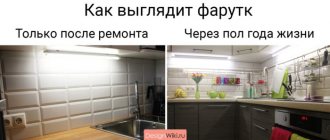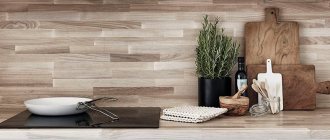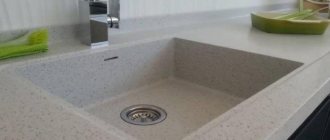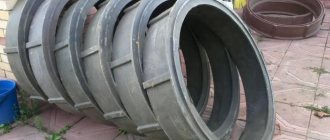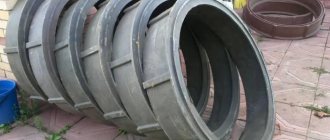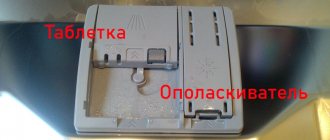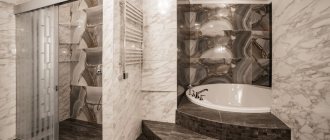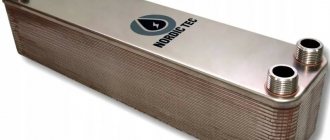Designers often decide for the owners what the kitchen apron will be like, offering the optimal solution in their opinion. However, many people prefer to do the repairs themselves, and when they begin to study this issue, they are surprised to discover a lot of finishing options. We will tell you what types of kitchen aprons there are, list their features, advantages and disadvantages so that you have complete information before starting the renovation.
In this article: [Hide]
- Ceramic tile apron In what case is it better to use
- Laminated wall panel backsplash
- In what case is it better to use
- Artificial stone apron
- In what case is it better to use
- Apron made of flexible veneer or flexible stone
- In what case is it better to use
- Tempered glass apron
- In what case is it better to use
- Apron made of wooden boiserie wall panel
- In what case is it better to use
- Mosaic apron
- In what case is it better to use
- Kitchen apron made of ABS plastic
- In what case is it better to use
- How to determine the size of a kitchen apron
Ceramic tile backsplash
Kitchen walls were tiled long before the term “kitchen apron” appeared. Ceramic tiles are still in demand and are represented on the finishing materials market in a wide range.
Popular sizes of ceramic tiles for kitchen splashbacks:
- 10 x 10 cm. Small square tiles open up wide possibilities for creating original compositions on the wall in the work area. The speed of work depends on the experience and complexity of the drawing;
- 7.5 x 15 cm. Vertical cladding of the apron with rectangular tiles looks very stylish, this option is perfect for modern interiors. If a loft is closer to you, this tile is the easiest way to create an imitation of brickwork;
- 20 x 30 cm. The first of the large-format types of wall tiles is ideal for an apron in a spacious kitchen. Putting it down is quick and easy.
Design options for ceramic tile backsplashes
As for the texture, this is a matter of taste. You can choose glossy or matte tiles.
Before tiling the apron, the wall must be carefully leveled.
In what case is it better to use
This type of kitchen apron is appreciated by adherents of traditions, by everyone who prefers a reliable, time-tested finish and wants to save money.
The advantages of ceramic tiles for a kitchen backsplash:
- Reliable protection of the entire wall surface, including behind the sink and stove.
- The ability to create an exclusive pattern using a play of colors and textures.
- Piece material, unlike sheet material, does not require cutting.
- When choosing inexpensive tiles, finishing will cost very little.
Disadvantages of ceramic tiles for a kitchen backsplash:
- Requires leveling of surfaces.
- To make it beautiful, you need to work carefully.
- The work itself is quite dirty.
- If the quantity is calculated inaccurately, there may not be enough tiles or there may be a surplus.
The labor intensity of the work is compensated by the durability of the finish. Cleaning a ceramic apron is very simple; it can only be cracked with a targeted blow to the wall. Therefore, it will serve for decades.
TOP 5 designer tips: how to choose tiles
Even if you are familiar with all the variety that can be used when designing a kitchen apron, before choosing it you need to think through the design of this area, taking into account the advice of designers:
1If the surface should only complement the kitchen furniture, then you need to choose a neutral design.
2If the apron should become the bright central spot of the kitchen, then the design can use photo printing, colorful mosaics, panels and other colorful design options.
3When choosing a bright, colorful design, you need to ensure that it is supported by elements of the kitchen interior that do not compete with it, but harmoniously complement it. It’s good if the worktop matches the color shades.
4Tiles of bright colors are best used in the design of a large kitchen space; for small kitchens, designers advise using a backsplash design in soothing pastel colors.
5Tiles of small sizes visually increase the area, large sizes, on the contrary, narrow the space.
Small tiles increase the area
Updating the interior with tiles with a large pattern
Laminated wall panel backsplash
Chipboards, better known as chipboards, are a good basis for making budget types of kitchen aprons.
To make the material resistant to moisture and temperature, it is laminated, that is, the slabs are finished with a polymer film impregnated with melamine resin. The resulting material is called chipboard. Chipboard lined with plastic has the same properties.
Chipboard with a thickness of 8-10 mm is suitable for a kitchen apron. Thicker slabs are used to make furniture.
The front surface of the material comes in a wide variety of colors and can imitate any texture, stone, for example, or wood.
Design options for aprons made of laminated wall panels
Apron made of laminated chipboard to look like stone.
Wood-look chipboard apron.
In what case is it better to use
If you want to quickly, cleanly and inexpensively tidy up the wall between the countertop and cabinets, consider that you have found the optimal type of kitchen apron. This option is suitable for renovations in your own or rented apartment, when you want to save time, money and nerves.
Advantages of a chipboard apron:
- Does not require careful leveling of walls as for tiles.
- Simple installation without the involvement of specialists.
- Presentable appearance of the finish.
- Resistance to humidity, heat from the stove.
- Good mechanical strength.
- Large assortment of decorative design of slabs.
- Low price.
Disadvantages of a chipboard apron:
- The finishing belongs to the must-market category, so no matter how much you want, it will not look rich and original.
- The durability of the apron depends on the quality of installation. Particular attention should be paid to the tightness of the joints in the corners, using special corners and if there is no edge, the edges of the apron should be sealed with sealant.
All this applies to chipboard with improved performance, that is, laminated or coated with plastic. Chipboard aprons should not be left in place , otherwise they will not be washed later. This is also a minus. But with proper attention, the finish will last in its original form for at least 10 years, and this is a big plus.
Artificial stone apron
A fashionable finishing material based on polyester resins with the addition of stone chips is produced under the name artificial stone. It looks quite realistic and noble, but weighs much less than its natural counterpart.
An artificial stone apron is usually made together with a countertop. During installation, they are monolithically glued together without forming seams. This feature of the installation and the absence of pores in the structure of the material eliminates the accumulation of dirt and the proliferation of microbes.
Design options for artificial stone aprons
In what case is it better to use
This type of kitchen apron will appeal to lovers of non-standard interior solutions and fans of the classic style. Classics and stone, even artificial ones, combine perfectly; the wall and table surface look rich and noble, especially in addition to wooden facades.
Advantages of an artificial stone apron:
- Hygiene.
- Absolute protection of walls from moisture.
- Impeccable appearance.
- Strength, durability.
- Defects acquired during operation can be easily eliminated by grinding.
Disadvantages of an artificial stone apron:
- A small number of color and texture solutions compared to other types of finishes.
- Quite a high price.
- Labor-intensive, responsible professional installation.
The disadvantages of this option for wall design are offset by the service life, calculated in decades.
No. 10. Metal: ideal for high-tech style
A metal apron will fit only into a modern-style interior . There are many advantages to such a solution: durability, resistance to fire and water, and chemicals . At the same time, you will have to put up with the fact that all the splashes , drips, and stains are clearly visible on the metal. They will need to be wiped regularly to ensure the coating looks perfect, but this is not that difficult, especially since you can get rid of dirt quite quickly.
The main disadvantage of this finish is its cold appearance, and there are very few possible colors. It is important to think through the interior of the kitchen very well so that such an apron looks truly organic and stylish. Moreover, this material reflects light very well, so you need to think through the lighting system so as not to end up with a room with an abundance of glare and sunbeams.
Apron made of flexible veneer or flexible stone
A thin section of natural stone on a soft artificial base is called flexible stone or flexible veneer.
Sandstone, often with a predominance of quartz, and other rocks are used to make finishing materials. The substrate is usually dense textiles, and the binding component is polymer resins. Available in rolls and slabs.
Flexible stone in the form of a roll.
Flexible stone in the form of a slab.
The finished material combines the decorative properties of stone and the elasticity of rubber.
Design options for aprons made of flexible stone
In what case is it better to use
This is a new finishing material that is rapidly gaining popularity. If you are attracted by the beauty of natural stone and are not bothered by the presence of seams during installation, choose this type of apron for the kitchen.
Advantages of an apron made of flexible stone:
- Externally indistinguishable from natural stone.
- Fireproof.
- Hygienic.
- The surface is resistant to mechanical stress.
- Thanks to its flexibility, it fits easily into corners.
- For high-quality wall cladding, you do not need the help of specialists.
Disadvantages of an apron made of flexible stone:
- Compared to ordinary artificial stone, it forms a seam at the junction with the countertop.
- Requires wall alignment.
- After cladding, the surface must be treated with a special protective primer.
- Quite a high cost.
Despite the shortcomings, this type of kitchen apron will last, according to experts, for at least 30 years.
In conclusion
A kitchen apron is regularly exposed to negative influences: splashes of water, drops of fat and various products, high temperature, frequent washing. All this makes us look for the most practical and resistant material to all this. Everyone wants the kitchen to be attractive, stylish and harmonious, so another requirement is put forward for the finishing material - a pleasant appearance. In addition to ceramic tiles, there are many other ways to decorate a kitchen working wall: when choosing one option or another, it is important to compare all the pros and cons, think about how the material fits into the kitchen conditions, and only then make a decision.
The article was written for the site.
Tags:Kitchen
Tempered glass apron
As soon as they appeared on the market, glass splashbacks immediately became the favorites of interior designers. We are talking about options with photo printing, which are called skinali and look incredibly impressive.
For the production of aprons, impact-resistant tempered glass, up to 8 mm thick, is used. It is not afraid of high temperatures and mechanical influences, but if, after making an effort, it is broken, the glass breaks into harmless fragments with rounded edges.
Today there are different types of tempered glass kitchen aprons on sale:
Transparent apron. The purpose of its installation is to additionally protect the existing finish from splashes of water and grease. If this option seems boring, you can order frosted glass or a texture, such as satin or sandblasting. Such solutions are found when decorating doors in shower stalls.
Transparent glass apron.
Plain (painted) apron. The paint is applied from the inside and undergoes heat treatment, so it does not lose its brightness throughout its service life. The number of color variations amounts to thousands of shades to suit every taste and every interior.
Plain glass apron.
Apron with UV printing. Using a special printer, an image is applied to the inner surface of the glass, and which one depends on the imagination of the designers. Under the influence of UV radiation, the picture freezes, impressing with its depth and expressiveness.
Apron with UV printing.
Design options for glass splashbacks
Each type of glass kitchen apron is good in its own way; the choice depends on the personal preferences of the owners.
In what case is it better to use
If you are going to decorate a kitchen in a Scandinavian style, you like neoclassicism, minimalism, hi-tech and other modern interiors, glass splashbacks are what you need.
Advantages of glass aprons:
- Strength.
- Hygiene.
- Thermal resistance.
- Infinitely large selection of design variations.
- Easy to clean like any glass.
Disadvantages of glass aprons:
- Careful alignment of the wall and additional finishing are required if the glass is transparent;
- Any technological holes are laid during production; it will not be possible to drill glass, for example, for roof rails;
- Water marks and dirt will be noticeable on the surface of the apron, so you will have to keep it clean, especially if sunlight falls on the glass.
As for skinals, they are so amazingly beautiful that they produce a wow effect even on people who are indifferent to interior design. At the same time, aesthetes and adherents of noble classics consider such aprons tasteless.
What other materials can be used?
This concludes the basic ideas about how to decorate an apron. Below are just a few very original options.
Chalkboard paint
A very original method is to make a slate slab instead of an apron. Simply cover the required area three times with chalkboard paint. It is easy to care for: avoid abrasive detergents and rough sponges.
Using a drawing on a board, you can change the look of your kitchen every day, and you definitely won’t get tired of it. It will look especially impressive in a white kitchen.
Brick
Natural brick or gesso are simply not suitable for backsplashes due to the porosity of the material: liquids and dirt will stick to the surface like a sponge and will be difficult to wash off.
Glass comes to the rescue again and protects this interesting design solution. The texture of the brick will be lost, so it is best to move the element away from the cooking area.
Oilcloth
Yes, you can make an apron out of oil fabric. This is one of the cheapest options you can make yourself. All you need to do is take the necessary measurements, select the oilcloth itself, and then attach it to the wall using a furniture stapler.
This option will save the walls from dirt and water, but for a gas stove it is better to choose another option - the oiler can also become charred.
Choosing the best apron for a given situation is not easy. Most often, people are guided only by aesthetics, but do not forget about other considerations:
- Budget;
- Planned period of use;
- Kitchen style;
- Difficulty of reconstruction and replacement;
- cleaning.
Focus on these factors and you'll enjoy your apron for years to come.
Acrylic
Roughly speaking, acrylic is a plastic that can imitate marble or oak. It is cheaper than stone, but is still an expensive option. Acrylic panels are connected virtually seamlessly, so hygiene is not an issue. Acrylic itself is a good material: it does not fade, does not fade, does not leave stains and is durable. Like glass, it gives enormous scope for imagination. But since it is based on polymers, it has certain limitations:
- it can melt next to the stove because it is afraid of high temperatures;
- does not like aggressive and abrasive detergents.
Acrylic looks great in the kitchen, for example, on facades, but is not the best choice for a backsplash.
Laminate or parquet
Laminate is preferred for use on backsplashes and is often cheaper than parquet. It is worth choosing high-class material (32-33) and good locks with moisture protection. You will have to install it yourself, since ready-made laminated panels for the apron are not sold. Installed using liquid nails.
A parquet apron is made differently: first, the “planks” are attached to the substrate with glue or liquid nails, then everything is varnished and also attached to the wall. But the varnish can melt or crack on the deck, so this method isn't for everyone. You can also cover the parquet with glass, but then the apron will be too thick - this is not suitable for everyone. But it looks very original.
Wallpaper
We are not talking about standard options, which are not very suitable for a kitchen apron, but about fiberglass wallpaper. It is durable and strong, and is resistant to extreme temperatures and moisture. There are many different textures available, but a uniform finish with no obvious unevenness is most suitable.
Gluing is no different from the usual process - level and prime the wall, then carefully adjust the fragments and level the surface. Let dry for a while and then coat with washable, waterproof paint. Then you can change the color at least twice a year, which is very convenient, because if you change the furniture, you won’t have to redo the apron.
Wine corks
Yes, that's right - they line the apron with wine corks. They not only collect them themselves, but also buy them (!) in bars and restaurants. To speed up the process, they are cut in half - this makes it easier to glue them to the ground.
The installation method is the same as for parquet flooring. Only corks are porous, so cleaning them will be a big problem. You can resort to an invariable assistant - glass, but is it worth adding it to an already thick apron? Wine stoppers are a good idea for the dining room, but not for the kitchen countertop.
Pebbles
If you love rocky beaches, you can create one in your kitchen. For example, an apron. But since the surface of the stone is not uniform, and it will be very difficult to clean it, dust will get between the stones, and as a result, such a panel will quickly lose its original appearance.
Apron made of wooden boiserie wall panel
From the palaces of the French aristocracy, boiserie migrated to our houses and apartments, including kitchen aprons. These are wall panel modules made of natural wood that resemble clapboard and are mounted in a groove. Boiserie can decorate the wall above the tabletop on its own or in combination with stone.
Design options for aprons made of wooden bowser panels
In what case is it better to use
In rustic interiors, especially Provence, this type of kitchen apron looks great, cozy and harmonious. If you are attracted to provincial motifs or eco-style, it is interesting to experiment with boiserie installation.
By the way, boiserie panels are used to decorate not only the work area, but also all the walls in the kitchen, especially if it is a kitchen-dining room. Often the installation is carried out to the middle of the wall, separated by transverse lamellas and continued higher.
Advantages of a boiserie apron:
- It looks cozy and original.
- You can always change the shade by tinting or “aging” it with patination.
- Few people have such kitchen aprons.
Disadvantages of a boiserie apron:
- Wood is hygroscopic, fire hazard and absorbs odors, so the panels will have to be periodically impregnated with special compounds.
- For the same reasons, it is not recommended to install them behind the sink and stove.
- It is quite difficult to clean the seams between the boards from dust and dirt.
Fragmentary installation of boiserie is an interesting idea that deserves attention, but sewing up an entire apron with them is not particularly practical.
Mosaic apron
The mosaic wall in the kitchen work area looks bright and original. However, many are stopped by the supposedly painstaking installation of small elements. In fact, this type of kitchen apron consists of blanks, usually 30 x 30 cm, which greatly simplifies installation.
The basis of the workpiece is a mesh onto which the mosaic is attached at the factory. Mosaic elements come in square, round, pebble, shell and other interesting shapes, not to mention colors.
Mosaic blanks are glued with tile adhesive; there is no need to be tricky with leveling the walls. But it is better to use epoxy grout; it does not absorb dirt and does not darken over time.
Mosaic apron design options
In what case is it better to use
Fans of colorful decors and ethnic motifs will definitely like this type of kitchen apron.
The size of the kitchen is not important, but it is worth considering that such a kaleidoscope will make a small room even smaller.
Advantages of a mosaic apron:
- You can choose from ceramics, glass, metal, stone, wood, or combine blanks from different collections.
- A mosaic apron is not afraid of moisture, especially if the seams are protected with epoxy grout.
- Good heat resistance allows you to lay mosaics on the wall behind the slab.
- No special skills are required to install mosaics.
Disadvantages of a mosaic apron:
- Epoxy grout is expensive and you will need a lot of it.
- The surface of the walls and seams will require careful care.
Considering that a mosaic apron will last about 2 decades for clean owners, investing in grout pays for itself.
Installation rules
Due to its high cost, porcelain stoneware aprons are most often used for heavy-duty coating. In order for the kitchen apron to hold firmly and serve for many years, it is necessary to follow all steps when laying the material.
Preparing the base
The main rule when preparing a wall is its smooth and clean surface. Here you must strictly follow a number of rules:
- Clean the walls from the plaster layer and peeling elements
- Fill all surface irregularities
- Corners should be straight if the material moves from corner to corner
- For better adhesion of the glue to the surface, it is worth making grooves on the wall
- Remove sockets and insulate wires
Laying porcelain stoneware slabs
Creating a porcelain stoneware backsplash consists of several steps:
Marking. To make an apron, you first need to calculate how many tiles you will need. To do this, you need to know the parameters of the floor cabinets and the height of the hanging cabinets.
Primer. You can create smooth walls on which the tiles will be laid using a deep penetration primer.
Guides. They are necessary to create an even tile layout. They serve as a support for the bottom row of tiles.
Angles. It is better to start laying tiles from the top corner. The adhesive solution must be applied to the wall and tiles. A short level can be used to check the evenness of the masonry. Then the whole process goes to the opposite corner. If the latter does not fit, then it can be adjusted to size using a grinder or tile cutter.
Applying glue. It is better to dilute the adhesive solution 2 hours before starting work, and the tile itself must be covered with the solution 15 minutes before adhesion. The product can be leveled within 10 minutes. The excess is removed using a notched spatula.
Holes. They are needed for sockets and switches. The mark is made in advance and drilled using a drill.
Seams. After finishing work, you should leave everything to dry for a day. After the required time has passed, rub the seams with a liquid of a plastic consistency. It must be prepared in advance. Using a rubber spatula, hammer the mixture into the seams and remove all excess. After half an hour, the surface can be washed to remove dirt.
Kitchen apron made of ABS plastic
Impact-resistant thermoplastic (ABS) replaced the usual PVC panels and immediately won the trust of consumers.
Unlike its flimsy predecessor, this is an environmentally friendly, durable material that is resistant to moisture and abrasives. The only similarity between these materials is their more than affordable cost.
Aprons made of ABS plastic come in any color, as well as imitation stone, wood or brick. Thanks to the ability to apply photo printing on ABS panels, you can purchase an option with an original design, almost like a skinali.
Design options for aprons made of ABC plastic
In what case is it better to use
If you want to save money on renovations, but budget chipboard or tiles don’t suit you, this type of kitchen apron will be an excellent alternative.
Another reason to choose this option is the desire to decorate the work area and have before your eyes not a stone or wood texture, but a field of tulips, city lights at night, or whatever you like best.
Advantages of an apron made of ABS plastic:
- Environmentally friendly.
- Thermal resistance up to + 80°C versus 45°C for PVC panels.
- Hygiene.
- Good mechanical strength;
- Lighter weight compared to tempered glass.
- Simple installation using liquid nails without special leveling of the walls.
- You can wash with abrasive sponges, but not with iron brushes.
- Budget cost.
Disadvantages of an apron made of ABS plastic:
- It is not advisable to place it behind a stove that is close to the wall.
- On the south side, panels with a bright pattern, unlike glass skinals, will fade.
The service life of this type of kitchen apron largely depends on the owners. With proper care and careful use, the walls in the work area will remain clean and beautiful for many years.
